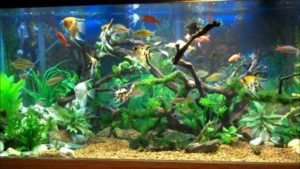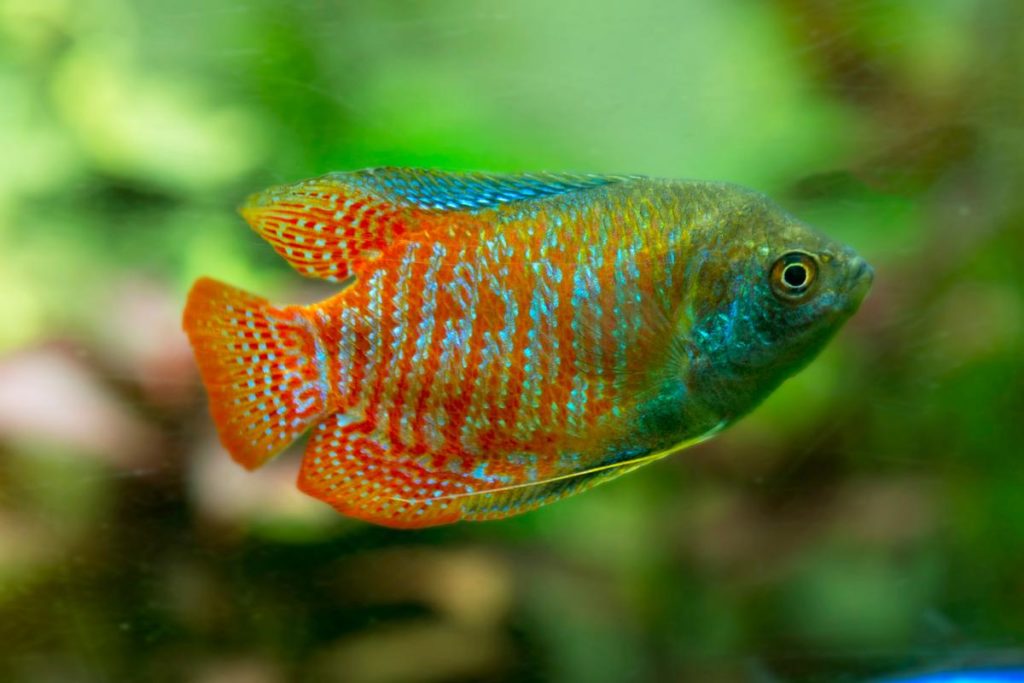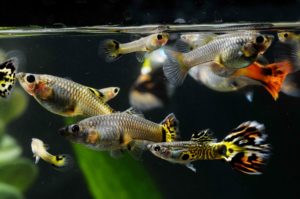Gourami fish make-up a medium to large fish family, relatives of Betta fish. Their scientific name is Trichogaster trichopterus. They are usually aquarium fish and bred in captivity. Know in this post everything related to these so varied fish.
Gourami fish are perciform fishes belonging to the Osphronemidae family, although the term Polyacanthidae is also used to refer to them. They are native to Asia, from Pakistan and India to the Malay Archipelago and to the northeast towards Korea.
Table Of Content
- 1 The Gourami Fish’ General Characteristics
- 2 Labyrinth Organ
- 3 Main species Of Gourami Fish
- 4 What Do Gourami Fish Eat?
- 5 The Gourami Fish’ Common Behavior
- 6 How Do Gouramis Reproduce?
The Gourami Fish’ General Characteristics
These are relatively resistant freshwater fish very suitable for most intermediate aquarists. There are around 90 recognized gourami species, most of which are bred in aquariums. They have a square, thin,compressed body as well as two thread-like long pelvic fins.
Gourami fish breathe by means of a special organ called labyrinth, just like the Betta fish. This peculiar trait makes them spend a big part of their time near the top of the water both in their natural habitat and in aquariums to breathe air. There is a huge variety of Gourami fish such as the blue, the honey, the golden, which we will meet following.
Many Gourami fish have an elongated ray resembling an eyelid located at the front of each of their pelvic fins. This species carry out parental care since some fish are oral incubated, since males take care of their offspring by keeping them inside their mouth for a long time. We invite you to read our article the anatomy of fish to learn more about such a topic
Labyrinth Organ
It’s quite common to see a Labyrinth fish climb to the top of the tank and swallow air from the water’s surface . Air is forced into the labyrinthine organ, to allow oxygen to be absorbed.
Inside the labyrinth, the cavities are many small labyrinthine compartments of thin, bony plates called lamellae. The lamellas are covered with extremely thin membranes, so thin that oxygen can pass through. The blood inside the membranes absorbs oxygen and transports it throughout the body.
If a labyrinth fish encounters little or even no water, it can stay alive for a long time, as long as it remains moist. In a hurry, some labyrinthine fish are able to crawl across the land to a different body of water. A labyrinth fish, the climbing perch, can even climb trees.
An interesting feature of this organ is that fish aren’t born with a fully functional labyrinthine organ. Instead, the labyrinth organ develops gradually, as the fish matures.
Let’s watch and learn
Main species Of Gourami Fish
Let’s meet the main species of this family
Blue Gourami “Three-spot Gourami” (Osphronemidae Family)
Morphology
The blue gourami fish has a compact body by the sides and a rounded shape. They possess a pair of tactile sensory organs to orient themselves in turbid waters, and that possess gustatory and olfactory buds.
Their body color varies since it can be blue, lilac, bluish green with a black point in the middle of the body, another one in the caudal fin, which in conjunction with their eyes grants them the nick name of “three points». The cultivated varieties lack such points, and they are the Marble Gurami (light blue with a darker variegation), and The Golden One.
Like all the Osphromenids the blue gouramis have a labyrinth organ, which serves to breathe air, allowing them to live in muddy and little oxygenated waters. They are practically the only fish capable of freeing an aquarium of hydra.
Size:
They are found in an average size of 10 to 15 cm.
Temperature:
From 22ºC to 30ºC
Social Behavior:
Satisfactory up to 8 cm, doubtful above this size.
Sexual differences:
Odd fins more developed, longer, sharper and pointed in the male. Females tend to be smaller with more rounded and shorter fins. These differences are quite difficult to distinguish until about 5 months of life.
Silver Gourami
This species was developed in captivity for the aquarium trade appearing for the first time in 1970. It is a three-point fish like the blue variety, with a more elongated body than other Gurami fish. Their body color is white with certain shades of yellow or silver, with a deep scratch on the back of its body that extends to the fins.
Gurami silvery fish can reach a total length of 15 centimeters, although the standard aquarium specimen measures about 13 centimeters in total length. Their life expectancy ranges between 4 to 6 years
Since this variety is developed by man, inbreeding is a common practice in this species so special care must be taken when choosing parents.
Let’s watch them
Honey Gourami
This is a species found in northern India and Bangladesh, and occasionally in Nepal. It’s an ideal fish for inexperienced aquarium lovers who are starting for the first time.
The Honey Gourami was first described by Hamilton and Buchanan in 1822, which confused males and females with two different species. The males were known as Trichopodus chuna and the females as Trichopodus sota. Now they all are known by the name of Trichogaster.
Trichogaster comes from the ancient Greek, ‘thriks’ which means ‘hair’ and ‘gaster’ which means ‘stomach’, which describes their long and narrow ventral fins. The fish available for the aquarium trade are all commercially produced. In recent years there has been a series of ornamental strains selectively bred to improve coloration between Dwarf Gourami (Colisa lalia) and honey Gourami. These two species have often been confused since they are similar.
They are often confused with the Dwarf Gourami as they have common traits in shape and size. By buying and selecting these fish, knowing their Latin scientific names (mentioned above) can help distinguish between different varieties.
The Honey Gourami body is narrower with smaller dorsal and anal fins. The ventral fins are narrow and threaded. Like most fish, males and females are of different colors.
Initially, all show a coloration of silvery gray to light yellow with a light brown horizontal strip in the middle of the body that extends from behind the eye to the caudal peduncle.
While the females retain this color for life, males develop a bright yellow honey or orange reddish coloration. The ventral side of the fish (face, throat and belly) will turn dark blue / black, while the main body will show a more orange-colored honey.
The Honey Gourami is the smallest fish of the genus Trichogaster, since males seldom reach more than 1.5 » and females 2″.
Here they are
Dwarf Gourami (Trichogaster lalius)
This species lives in the Northwest of India, in Ganges, Yamuna, and Brahmaputra. Dwarf Gourami can be found in the fresh waters of thick vegetation.
In the river plains of northern India, they are one of the most common fish, and are sold dry or as fishmeal in many of the markets. The scientific name of these fish is Colisa lalia being usually called Dwarf Colisa. Dwarf Gourami fish belong to the Osphromenidae family and the Perciform order. They are calm fish with a life span of about 4 years.
Morphology
Dwarf fish have a compacted body by the sides, as well as apair of tactile barbells at the base of the belly.
They present sexual dimorphism since males are slightly larger than females. The dorsal and anal fins in males are more developed, and their bodies are bright orange – red with vertical turquoise blue stripes that extend into the fins. Dwarf Gourami females are more opaque, silver-gray blue. There are also several hybrid colored fish.
These fish have the mouth directed upwards and the lower lip prominent. They have a supra branchial organ called a labyrinth through which they can trap oxygen directly from the atmosphere.
In terms of size, they can measure up to 5 cm and in their natural habitat reaches 7 cm.
Coloration
It’s very varied. The most common is characterized by electric blue stripes on a red background that covers the entire body; the fins are red with blue mottling. The females usually have a silver color.
Let’s meet them
Pearl Gourami «Trichogaster leerii»
Due to the patterns throughout their body, they are also known as diamond or mosaic gurami, but these names are less common. Pearl Gouramis are native to Thailand, Malaysia and Indonesia. They live in shallow tropical waters with abundant vegetation and acid water.
Nowadays they can be found all over the world because they are bred in captivity for the fishing industry. These fish can sometimes be demanding, so they are only recommended for those who have some experience under their belt. With a little knowledge they are quite easy to maintain which makes them popular for domestic aquariums, especially when combined with their intricate patterns that make them one of the most striking tropical fish in the world.
Pearly Guramis’ characteristic behavior
The pearl gourami’s share many behavior traits with other gourami species. Most of their time will be spent swimming around the tank’s middle to upper levels.
Occasionally you will see them go to the surface looking for oxygen. During spawning they can become particularly aggressive. The males are the most aggressive since they will fight for the females and drive away any fish that approaches their nest. The rest of the time they are quite peaceful and don’t usually bother tank mates.
Appearance
Their appearance is the main reason why pearly gouramis are a sought-after species. It’s difficult to deny their beauty. Their body is covered with white spots, like pearls, that give them their name as well as a thin black bar runs along its side.
The spots make them easily distinguishable from other gourami species, but their fins, size and colors are also different.
They have thin, large and wide fins which give them an elegant and delicate appearance. Since their fins are so large, they are a prime target for fin-biting fishes, so keep them separate.
You can see a pair of modified pelvic fins hanging below them while swimming. These thin fins are almost as long as the body. In terms of size, the pearly gourami can grow up to 4-5 inches.
It’s easy to distinguish males and females. The males develop a red breast as they mature, which becomes brighter when they mate and makes them one of the most colorful fish around. Their dorsal fins are longer too.
Here they are
Moonlight Gourami (Trichopodus microlepis).
The Trichogaster microlepis (also known as Moonbream Gourami) lives in Vietnam, Thailand, Borneo, Sumatra, Laos, and Malaysia, in rivers like the Mekong .
It has a silvery white color with a slight yellowish ans/or blueish green hue. This is a shy, peaceful, calm and territorial species.
Natural habitat
Swamps, rice fields and pools of standing water with little current.
Shape – Morphology
The moonlight gourami has a slender and elongated body slightly compressed, with two tactile rods that use as sensory organs to orient themselves in turbid waters. The «slope» of the head is concave, unlike other guramis, the iris of the eye is surrounded by yellow.
Like all the fish in the family, the Moonlight gourami has a labyrinth organ, which allows it to breathe directly from the air, so it is usual to see him rise to the surface and take a breath.
Feeding Habits
Omnivore. In the wild they basically feed on insect larvae, in particular mosquitoes, zooplankton and aquatic insects. In captivity they accept any type of commercial food, flakes, granules, freeze-dried frozen, and especially live.
Coloration
As its name suggests it is silver-white with iridescent blue, green and yellow tones, depending on the angle of light and its brightness. The fins are completely transparent.
Behavior
Trichogaster microlepis is mainly peaceful, shy, calm and territorial with other labyrinthids. Males are usually aggressive among themselves for territorial reasons. For this reason, just like the bettas, it is only recommended to have one male per aquarium or to have a minimum aquarium of 300 liters.
Sociability
This is a suitable species for community aquariums.
here they are
Https://www.youtube.com/watch?v=XrefIzQYCOI
Snakeskin Gourami (Trichogaster Pectoralis)
Distribution:
Laos, Thailand, Cambodia and Vietnam. Although they have been introduced in other areas for later commercialization as food.
Shape:
Like the rest of the labyrinths, the snakeskin Gourami is an elongated and laterally compressed fish that lacks adipose fin. Their pelvic fins have been transformed into filiform and exceed the caudal peduncle. The mouth, with thick lips, is placed in the upper position. His eyes are large, and they are crossed by a black band that runs through his body.
Coloration:
Top light brown that becomes golden and then silver as it approaches the ventral area. On this one we find clearer transverse bands and with a black zig-zag longitudinal band that runs through the body from the mouth to the caudal fin.
Size:
In their wild state Snake skin Gourami reach up to 25cm, although in captivity they tend to stay between 15-20cm.
Let’s watch them
What Do Gourami Fish Eat?
Gourami fish are omnivorous creatures, although as primary food they consume animal material rather than vegetable. It’s weird to see them biting plants and prefer algae as the vegetable part of their diet. These fish accept food in flake form, although if you have access to live food it would a very good option, since it develops healthier fish and improves its reproductive condition . These foods can also be administered frozen.
The pearly gourami has a small mouth in proportion to its size, so they must be fed with chopped elements such as worms.
The Gourami Fish’ Common Behavior
Gourami usually have different behaviors. For example blue gourami fish are usually quiet when they are small, but not as peaceful as the other classifications of this species. This variety usually attacks smaller fish when they are adults, so it’s recommended to have them in aquariums with fish of their same size.
It’s possible that gourami fish show different levels of aggressivenes, since some of them may have a bad behavior with their peers while others may be so peaceful to the point of shyness. It’s necessary that as owners be prepared to adapt peers according to each specimen’s behavior.
Let’s watch them again
Https://www.youtube.com/watch?v=L4dVYhjaeBA
How Do Gouramis Reproduce?
The Gouramis’ courtship is curious. During the process it’s common for the couple to touch with their pectoral fins modified in the form of an antenna. The male creates a layer of bubbles on the surface of the water, which will be where the fertilized eggs will be deposited. They tend to fall to the bottom, but the male picks them up and puts them in the layer of bubbles where they stay for around 3 days. When they begin to leave it’s advisable to separate the male so that he does not devour the small fry. At first the fry will feed on their yolk sac and later on the food provided.
Care
The gouramis are shy, solitary and peaceful fish that coexist well with other quiet species. However, it is advisable not to bring together in the same aquarium two male gouramis, since they are rivals between them and could get to fight.
Next to this, the only time where they can show a little more aggressive is when they are raising their fry. They are very territorial parents which will protect their young at any cost.
Their care is very simple. They are omnivorous, so they can be given all kinds of food and aren’t very demanding with water conditions.
The only caprice that guramis ask is to have surface plants to build their famous bubble nest and to increase their family.
In order for gouramis to reproduce in the aquarium, certain conditions must be guaranteed. It’s recommended to have an aquarium for reproduction in addition to the community one, so that they can be calm and make their nest of bubbles, to carry out their courtship, preventing this way other fish from eating the eggs or the fry.
This breeding aquarium should have the recommended p.H, temperature and hardness conditions for adults. It must have low current filtration on the surface so that it does not destroy the bubble nest.
Keep in mind to provide live food to the parents one week before moving them to the breeding aquarium, so that they are in optimal conditions for spawning. First the female is passed to the breeding tank and after a few hours or a day of adaptation the male is passed.
 Afterwards, the male is expected to chase the female incessantly and make the courtship. This courtship includes the construction of the bubble nest on the surface of the water, for which you can use bits of plants. When the female spawns he fertilizes the eggs and blows them into the bubbles of the nest. The laying is about 1000 eggs.
Afterwards, the male is expected to chase the female incessantly and make the courtship. This courtship includes the construction of the bubble nest on the surface of the water, for which you can use bits of plants. When the female spawns he fertilizes the eggs and blows them into the bubbles of the nest. The laying is about 1000 eggs.
At this time it is best to remove the female because male gourami becomes very protective of their nest. The eggs hatch in 24 to 30 hours. The male retrieves each fish and blows it back into a bubble. This is a stressful process for him, thus, he must be removed after two days to prevent him from eating the young.
On the fourth day of birth, the small gouramis have already absorbed the yolk sac and can be observed in the middle region of the water looking for food. They should be provided with small food such as rotifers or paramecium, at about seven days they can be given brine shrimp.
During all this time care should be taken that the filters don’t suck the small ones to a death by putting a sponge that prevents it. A good quality of water must be maintained, making partial water changes since a lot of food is being added that can contaminate it.
Between the sixth and eighth week the little fish develop the labyrinth, which is the organ with which they will breathe the rest of their lives. This is an important stage and attention must be paid so that there is no difference between the water temperature and that of the air which is between the water and the lid.
Compatibility with other fish
Gouramis are shy fish, who like to have their own space and tranquility. Therefore, gouramis aren’t suitable to live with any species of fish.
It’s not advisable to gather several males and females, since we will provoke fights for the territory, the space for all the males should be calculated.
Some species that are compatible with the gurami:
- Tetra
- Catfish
- Angel fish
- Botias
- Guppys
- Swords or Xiphophorus
- Neons
- Other small and calm fish
We invite you to read our article Tetra fish to learn more about this beautiful species.
Some species that are NOT compatible with the gurami:
- Betta
- Other gouramis
- Fish with large fins
- Fish with veiled fins
- Large or aggressive fish
- Very colorful fish
Here they are




